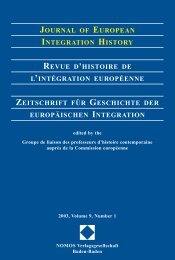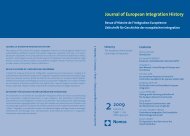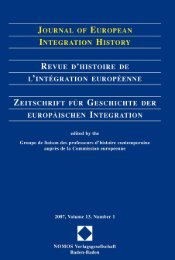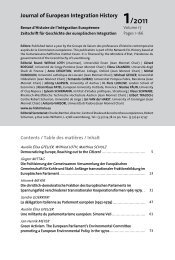journal of european integration history revue d'histoire de l ...
journal of european integration history revue d'histoire de l ...
journal of european integration history revue d'histoire de l ...
You also want an ePaper? Increase the reach of your titles
YUMPU automatically turns print PDFs into web optimized ePapers that Google loves.
Choosing the Periphery 97<br />
Norwegian exports due to the EEC's common external tariff (CET) was about<br />
eighty-five percent, i.e. NOK 300 million in 1961. According to minister <strong>of</strong> Industry<br />
Kjell Holler the total tariff bur<strong>de</strong>n would then be approximately ten per cent <strong>of</strong><br />
total turnover, while the average pr<strong>of</strong>it was fifteen percent. The CET would thus reduce<br />
Norwegian industry pr<strong>of</strong>its by a sixty-six percent and remove the ability <strong>of</strong> industry<br />
to finance the planned expansion itself. The government was afraid that the<br />
EEC tariff union would threaten the export industry's ability to expand. However,<br />
this fear vanished subsequently due to schemes ensuring that a major part <strong>of</strong> Norwegian<br />
exports to the EEC was not exposed to tariff increases by the transition to<br />
the common external tariff. Actually, in 1970, forty-two per cent <strong>of</strong> Norway's total<br />
exports to the EEC, including aluminium and ferro-alloys, were subjected to special<br />
tariff schemes. 62 Originally List G had been perceived as a major threat to the<br />
traditional export industry. However, it turned out that items on List G were treated<br />
much better than expected. Therefore, a favourable List G was perceived as more<br />
important to sustain traditional exports than EFTA membership. The major concern<br />
with respect to the EEC was that schemes un<strong>de</strong>r List G would be discar<strong>de</strong>d.<br />
During the first negotiations <strong>of</strong> the Kennedy round in GATT, the government<br />
sensed that the Six, now negotiating jointly through the Commission, would give<br />
priority to protection and weaken the favourable schemes for the traditional Norwegian<br />
export industry. Foreign minister Halvard Lange anticipated that forty per cent<br />
<strong>of</strong> exports to the EEC were threatened. 63 For Norway, the Kennedy round received<br />
a far higher priority than EFTA's Vienna initiative in May 1965, which inten<strong>de</strong>d to<br />
arrange a joint meeting at ministerial level between the two preferential trading<br />
groups in or<strong>de</strong>r to solve commercial problems. The Norwegian government successfully<br />
joined forces with other Nordic governments and negotiated jointly a unified<br />
contracting party to GATT in or<strong>de</strong>r to counteract the anticipated protectionist<br />
policy <strong>of</strong> the Six. Norway placed less confi<strong>de</strong>nce in the British after the introduction<br />
<strong>of</strong> the import surcharge. Actually, when it comes to manufacturing industry,<br />
the main problem for Norway during the accession negotiations with the Community<br />
in 1970-72 was British <strong>de</strong>mands for tariff quotas that would hurt traditional<br />
Norwegian export.<br />
Throughout the 1960s the Norwegian authorities nevertheless supported the<br />
i<strong>de</strong>a <strong>of</strong> bridge building between EFTA and the EEC, and felt that a solution would<br />
lie closer to the Treaty <strong>of</strong> Rome than to the Stockholm convention. 64 However, they<br />
continuously insisted on multilateral negotiations, which would not inclu<strong>de</strong> the primary<br />
sector. When the government supported commercial arrangements between<br />
the four applicants and the Community after French presi<strong>de</strong>nt Charles <strong>de</strong> Gaulle's<br />
veto in 1967, the intention was not to facilitate the possibility <strong>of</strong> any future EEC<br />
membership but, according to John Lyng, minister <strong>of</strong> Foreign affairs, to “prevent<br />
further splits between market groups in Europe”. 65 EFTA provi<strong>de</strong>d a good balance<br />
62. St.m. No.50, 1971-72, op.cit., p.31.<br />
63. SA, SUUKK, Minutes <strong>of</strong> 22 October 1964, p.23.<br />
64. UD, 44.36/6.84 vol.25, Note on Norway and the Community, 4 February 1966.<br />
65. SA, SUUKK, Minutes <strong>of</strong> 5 February 1968, p.7.

















